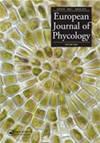Comparative FISH mapping of 45S and 5S rDNA in the genus Gambierdiscus advances understanding of the cytogenetic diversity and mitosis of dinoflagellates
IF 1.7
4区 生物学
Q2 MARINE & FRESHWATER BIOLOGY
引用次数: 4
Abstract
ABSTRACT Dinoflagellates are protists with exceptionally large genomes and chromosomes that lack nucleosomes. To date, information on their genome organization is scarce. Studies investigating the distribution of ribosomal RNA genes (rDNA) in plants and animals by fluorescence in situ hybridization (FISH) have provided important information to elucidate the genome organization and evolution of many species. In the present study, FISH was used to analyse the chromosomal organization of 45S and 5S rDNA and the extent of rDNA variation among five species of Gambierdiscus (G. australes, G. excentricus, G. silvae, G. carolinianus and G. caribaeus). The results, the intensity and location of the FISH signals, are summarized as follows: (1) All Gambierdiscus species have extremely high copy number of 45S rDNA repeat units arranged in a large nucleolus situated in the concave region of the typical interphasic bean-shaped nucleus. In addition, outside the large nucleolus, G. silvae and G. carolinianus have minor clusters of 45S rDNA repeats. (2) Many copies of 5S rDNA organized in one or a few clusters, depending on the species, are physically separated from the 45S rDNA but located close, peripherally, to the nucleolus. This nuclear organization is preserved during cell division. (3) Gambierdiscus australes was the species with the lowest 5S rDNA FISH signals clustered into a single site. In contrast, one major and several minor 5S rDNA clusters of FISH signals were observed in G. excentricus. We find that the species analysed can be differentiated by their species-specific FISH rDNA phenotypes demonstrating the usefulness of FISH in comparative cytogenomic studies of Gambierdiscus. In addition, using G. australes as a model, we demonstrate the usefulness of 45S and 5S rDNA as chromosomal markers to study dinomitosis, the atypical nuclear division that solely occurs in the class Dinophyceae.Gambierdiscus属45S和5S rDNA的比较FISH定位促进了对甲藻细胞遗传学多样性和有丝分裂的理解
鞭毛藻是具有异常大的基因组和缺乏核小体的染色体的原生生物。迄今为止,关于它们基因组组织的信息很少。利用荧光原位杂交技术(FISH)研究核糖体RNA基因(rDNA)在动植物中的分布,为阐明许多物种的基因组组织和进化提供了重要信息。本研究采用FISH方法分析了5种冈比鱼(G. australes、G. excentricus、G. silvae、G. carolinianus和G. caribaeus) 45S和5S rDNA的染色体组织及变异程度。结果表明,FISH信号的强度和位置如下:(1)所有冈比鲑种的45S rDNA重复单元拷贝数极高,这些重复单元排列在典型的豆状核凹区大核仁内。此外,在大核仁之外,G. silvae和G. carolinianus有少量的45S rDNA重复序列。(2)根据物种的不同,许多组成一个或几个簇的5S rDNA拷贝在物理上与45S rDNA分离,但位于核仁附近。这种核组织在细胞分裂过程中被保存下来。(3)南Gambierdiscus australes是5S rDNA FISH信号聚集在单个位点的最低物种。相比之下,在黄颡鱼中观察到一个主要的和几个次要的5S rDNA信号簇。我们发现所分析的物种可以通过其物种特异性的FISH rDNA表型来区分,这表明FISH在冈比亚铁砧的比较细胞基因组研究中是有用的。此外,我们以南方龙科为模型,证明了45S和5S rDNA作为染色体标记在研究恐龙分裂(仅发生在恐龙纲中的非典型核分裂)方面的有效性。
本文章由计算机程序翻译,如有差异,请以英文原文为准。
求助全文
约1分钟内获得全文
求助全文
来源期刊

European Journal of Phycology
生物-海洋与淡水生物学
CiteScore
4.80
自引率
4.20%
发文量
37
审稿时长
>12 weeks
期刊介绍:
The European Journal of Phycology is an important focus for the activities of algal researchers all over the world. The Editors-in-Chief are assisted by an international team of Associate Editors who are experts in the following fields: macroalgal ecology, microalgal ecology, physiology and biochemistry, cell biology, molecular biology, macroalgal and microalgal systematics, applied phycology and biotechnology. The European Journal of Phycology publishes papers on all aspects of algae, including cyanobacteria. Articles may be in the form of primary research papers and reviews of topical subjects.
The journal publishes high quality research and is well cited, with a consistently good Impact Factor.
 求助内容:
求助内容: 应助结果提醒方式:
应助结果提醒方式:


